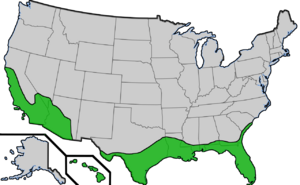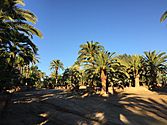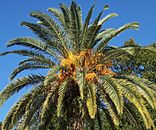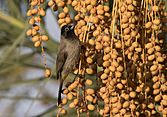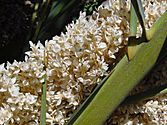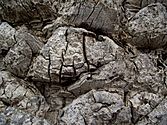Canary Island date palm facts for kids
Quick facts for kids Canary Island date palm |
|
|---|---|
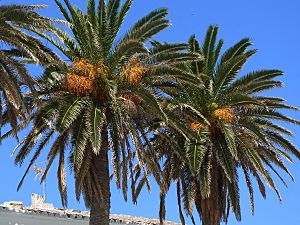 |
|
| Conservation status | |
| Scientific classification | |
| Genus: |
Phoenix
|
| Species: |
canariensis
|
Phoenix canariensis, the Canary Island date palm or pineapple palm, is a species of flowering plant in the palm family Arecaceae, native to the Canary Islands off the coast of Morocco. It is a relative of Phoenix dactylifera, the true date palm. It is the natural symbol of the Canary Islands, together with the canary Serinus canaria. Mature P. canariensis are often used in ornamental landscaping and are collected and transplanted to their new planting location. A Canary Island date palm with 10 m (30 ft) of trunk is approximately 60 years of age.
Description
Phoenix canariensis is a large solitary palm, 10–20 m (33–66 ft) tall, occasionally growing to 40 m (131 ft). The leaves, typically around 75 to 125 in number (but the record is for a tree on the French Riviera which bore 443 green, fresh leaves at one time), , are pinnate, 4–6 m (13–20 ft) long, with 80–100 leaflets on each side of the central rachis. The fruit is an oval, yellow to orange drupe 2 cm (0.79 in) long and 1 cm (0.39 in) in diameter and containing a single large seed; the fruit pulp is edible but not the best of dates.
Names
Common names in English include Canary Island date palm and pineapple palm. The common name in Spanish-speaking countries and in the Canary Islands is palmera canaria.
Cultivation
The Canary Island date palm is typically cultivated in wet-winter or Mediterranean climates, but also in wet-summer or humid subtropical climates like eastern Australia and the southeastern United States. There are even several instances of cultivated Canary Island date palms in high-latitude oceanic climates, such as Ireland, the UK, and the Channel Islands. It can be cultivated where temperatures rarely fall below −10 or −12 °C (14 or 10 °F) for extended periods, although it will require some protection if cold periods are longer than normal. It is a slowly growing tree, exclusively propagated by seed.
The palm is easily recognized through its crown of leaves and trunk characteristics. It is not uncommon to see Canary Island date palms pruned and trimmed to enhance the appearance. When pruned, the bottom of the crown, also called the nut, appears to have a pineapple shape.
The Canary Island date palm is susceptible to Fusarium wilt, a fungal disease commonly transmitted through contaminated seed, soil, and pruning tools. Spread of the disease can be reduced when pruning tools are disinfected before use on this palm. The South American palm weevil causes them to droop, turn brown and die.[1]
It has gained the Royal Horticultural Society's Award of Garden Merit.
Use in Landscaping
The Canary Island date appears in many notable examples of landscaping, particularly in the American state of California. The Canary Island date palm, according to legend, was first planted in what is now San Diego in 1769 by Spanish missionary Junípero Serra, a founder of the California mission system. Though this story is likely false, Spanish missionaries did cultivate true date palms, rather than Canary Island date palms, in California in the late 1700s for the fruit. However, a Canary Island date palm was famously known as "The Serra Palm"--the palm supposedly planted by Junipero Serra in San Diego--before the tree's death in 1957.
Other famous plantings of the Canary Island date palm in California include the campus of Stanford University, which contains 600 of Canary Island date palms in its Mediterranean-inspired campus. Stanford's entrance, Palm Drive, is one example of extensive use of the Canary Island date palm in landscaping, including 166 of the species along the stretch leading to the campus. Oracle Park in San Francisco--the stadium of the Major League Baseball team, the San Francisco Giants, is another notable example of the Canary Island date palm in Californian landscaping, containing a host of the species at the stadium's entrance and beyond left field.
Other uses
In the Canary Islands, the sap of this date palm is used to make palm syrup. La Gomera is the only island where the syrup is produced in the Canary Islands.
Invasiveness
In some areas, Phoenix canariensis has proven to be an invasive plant. In Bermuda and the United States (Florida and California) it is considered naturalised (lives wild in a region where it is not indigenous). It has also spread in some areas of peninsular Spain, Portugal, Italy, Australia, and New Zealand. It is listed as invasive (naturalized) in coastal southern California. In Auckland, New Zealand, the palm has itself become a host for the naturalised Australian strangler fig, Ficus macrophylla.
Gallery
See also
 In Spanish: Palma fénix para niños
In Spanish: Palma fénix para niños
- List of animal and plant symbols of the Canary Islands



